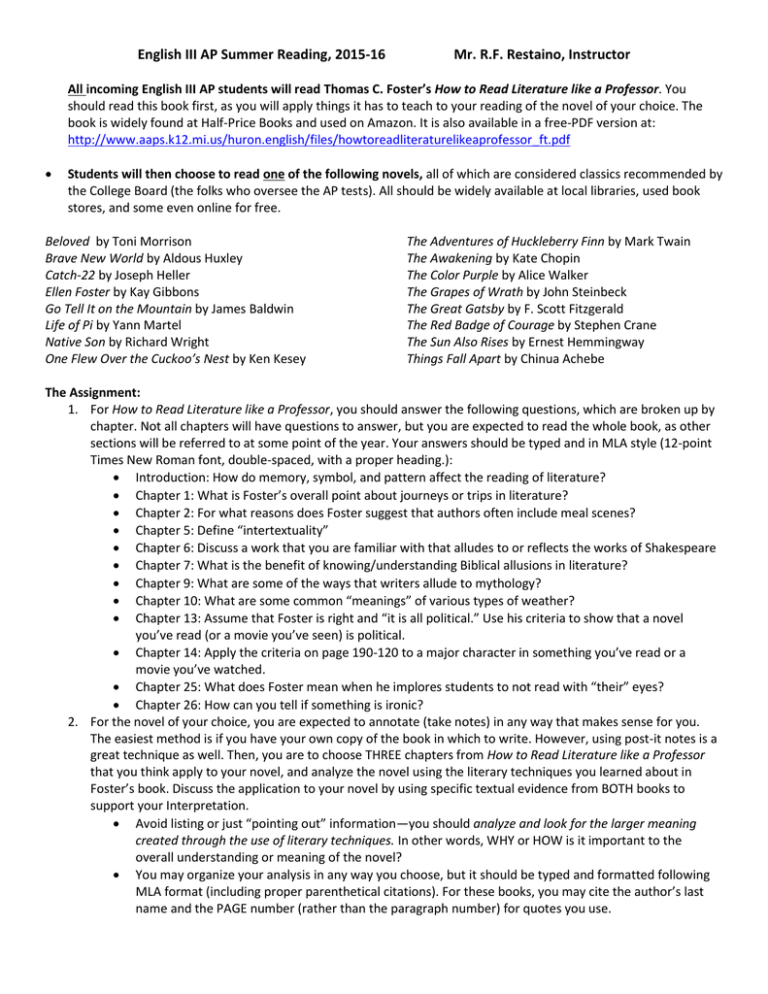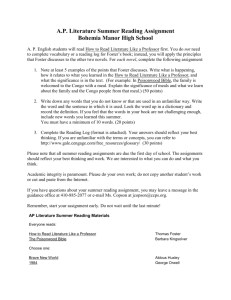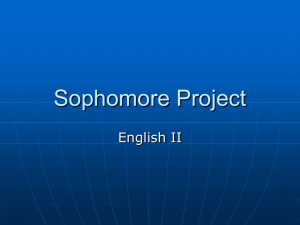AP English Language & Composition Summer Reading Assignment
advertisement

English III AP Summer Reading, 2015-16 Mr. R.F. Restaino, Instructor All incoming English III AP students will read Thomas C. Foster’s How to Read Literature like a Professor. You should read this book first, as you will apply things it has to teach to your reading of the novel of your choice. The book is widely found at Half-Price Books and used on Amazon. It is also available in a free-PDF version at: http://www.aaps.k12.mi.us/huron.english/files/howtoreadliteraturelikeaprofessor_ft.pdf Students will then choose to read one of the following novels, all of which are considered classics recommended by the College Board (the folks who oversee the AP tests). All should be widely available at local libraries, used book stores, and some even online for free. Beloved by Toni Morrison Brave New World by Aldous Huxley Catch-22 by Joseph Heller Ellen Foster by Kay Gibbons Go Tell It on the Mountain by James Baldwin Life of Pi by Yann Martel Native Son by Richard Wright One Flew Over the Cuckoo’s Nest by Ken Kesey The Adventures of Huckleberry Finn by Mark Twain The Awakening by Kate Chopin The Color Purple by Alice Walker The Grapes of Wrath by John Steinbeck The Great Gatsby by F. Scott Fitzgerald The Red Badge of Courage by Stephen Crane The Sun Also Rises by Ernest Hemmingway Things Fall Apart by Chinua Achebe The Assignment: 1. For How to Read Literature like a Professor, you should answer the following questions, which are broken up by chapter. Not all chapters will have questions to answer, but you are expected to read the whole book, as other sections will be referred to at some point of the year. Your answers should be typed and in MLA style (12-point Times New Roman font, double-spaced, with a proper heading.): Introduction: How do memory, symbol, and pattern affect the reading of literature? Chapter 1: What is Foster’s overall point about journeys or trips in literature? Chapter 2: For what reasons does Foster suggest that authors often include meal scenes? Chapter 5: Define “intertextuality” Chapter 6: Discuss a work that you are familiar with that alludes to or reflects the works of Shakespeare Chapter 7: What is the benefit of knowing/understanding Biblical allusions in literature? Chapter 9: What are some of the ways that writers allude to mythology? Chapter 10: What are some common “meanings” of various types of weather? Chapter 13: Assume that Foster is right and “it is all political.” Use his criteria to show that a novel you’ve read (or a movie you’ve seen) is political. Chapter 14: Apply the criteria on page 190-120 to a major character in something you’ve read or a movie you’ve watched. Chapter 25: What does Foster mean when he implores students to not read with “their” eyes? Chapter 26: How can you tell if something is ironic? 2. For the novel of your choice, you are expected to annotate (take notes) in any way that makes sense for you. The easiest method is if you have your own copy of the book in which to write. However, using post-it notes is a great technique as well. Then, you are to choose THREE chapters from How to Read Literature like a Professor that you think apply to your novel, and analyze the novel using the literary techniques you learned about in Foster’s book. Discuss the application to your novel by using specific textual evidence from BOTH books to support your Interpretation. Avoid listing or just “pointing out” information—you should analyze and look for the larger meaning created through the use of literary techniques. In other words, WHY or HOW is it important to the overall understanding or meaning of the novel? You may organize your analysis in any way you choose, but it should be typed and formatted following MLA format (including proper parenthetical citations). For these books, you may cite the author’s last name and the PAGE number (rather than the paragraph number) for quotes you use.




